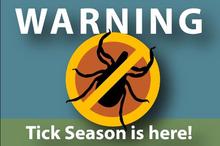
As people start heading outdoors this summer, it is important to remember to take preventive measures against ticks. While it is a good idea to take precautions year-round in Ohio, be extra vigilant as temperatures warm and ticks become more active.
Bit by a Tick?
What you need to know about Ticks in Ohio
Bit by a Tick?
Ticks are arachnids, relatives of spiders that live in wooded areas, brushy fields, along trails and around homes. They are also parasites that survive by feeding on the blood of animal hosts, including humans. Through their feeding, ticks can significantly impact the quality of life and health of humans and pets. Most importantly, some species of ticks may transmit diseases, which can result in mild to serious illness or death. Lyme disease can be transmitted to humans through the bite of infected blacklegged ticks. Typical symptoms include fever, headache, fatigue and a characteristic skin rash called erythema migrans (the “bull’s-eye” rash). If left untreated, infection can spread to the joints, heart and nervous system. Lyme disease is diagnosed based on symptoms, physical findings (e.g., rash) and the possibility of exposure to infected ticks; laboratory testing is helpful if used correctly and performed with validated methods. Most cases of Lyme disease can be treated successfully with a few weeks of antibiotics. Steps to prevent Lyme disease include using insect repellent, removing ticks promptly, applying pesticides and reducing tick habitat. The ticks that transmit Lyme disease can occasionally transmit other tick-borne diseases as well.
It is also important to note that, although Lyme disease is the most common tick-borne disease (especially in this region), it is not the only illness transmitted by ticks. Other notable tick-borne illnesses include: Rocky Mountain Spotted Fever, Ehrlichiosis, Anaplasmosis and others.
Proper protection from ticks and prompt removal are crucial to preventing infection. If you have been bitten by a tick, you can have it identified for potential risk of infection from Lyme disease. Click the link above for more information. The best defense against Lyme disease and other tick-borne diseases is protection from tick bites. Ticks do not jump or fly onto humans, but wait on low vegetation and attach themselves to hosts (mice, deer and humans) as they walk by. The following steps will help protect against Lyme disease:
- Conduct tick checks on yourself, your children and your pets every four to six hours for several days after you have been in a tick infested area. Because the blacklegged tick is very small, about the size of the head of a pin or smaller, it is especially important to thoroughly check for ticks after being in areas where they live.
- Wear light-colored clothing so that ticks are easier to see and remove.
- Minimize exposure to ticks. Tuck pant legs into socks and boots. Wear long-sleeved shirts buttoned at the wrist. Tuck shirts into pants to keep ticks on the outside of clothing.
- Carefully remove attached ticks promptly – transfer of the disease usually takes 24 hours or more.
- Around your home modify your landscape to make the area less hospitable to ticks. Keep grass cut and underbrush thinned in yards. Remove leaf litter, prune trees, and clear underbrush/woodpiles- resisting the urge to move such debris to the nearby wood edge where it will improve habitat for nesting ticks and their hosts. Increasing sunlight reaching the yard can significantly reduce the number of ticks in some areas.
The state of Connecticut has put out a manual with information on how to reduce ticks around the home - http://www.ct.gov/caes/lib/caes/documents/special_features/tickhandbook.pdf (PDF, 7MB). - Eliminate the living places of small rodents.
- Follow directions carefully if chemicals are used for tick control or hire a professional.
- Avoid tick-infested areas such as tall grass and dense vegetation, and walk in the center of mowed trails, while hiking, to avoid brushing against vegetation.
- If you are outdoors regularly, in areas thought to harbor ticks, consider long-lasting “Permethrin” repellents for clothing. Apply tick repellent to areas of the body and clothing that may come in contact with grass and brush. Repellents include those containing up to 50% DEET for adults or less than 30% for children. A repellent/pesticide containing 0.5 percent Permethrin may be applied to clothing, but should not be used on skin.
- Follow directions carefully and do not overuse repellents. Some tick repellents can cause toxic or allergic reactions.
- Ask your veterinarian to recommend tick control methods for your pets. Animals can get Lyme disease but they do not transmit these diseases to humans. However, pets can bring ticks into your house.

